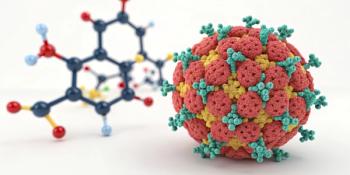
Rosuvastatin effective at slowing progression of asymptomatic aortic stenosis
Prospective treatment with rosuvastatin can slow the hemodynamic progression of asymptomatic aortic stenosis. This was the conclusion of the prospective, open-label Rosuvastatin Affecting Aortic Valve Endothelium (RAAVE) trial.
Key Points
Prospective treatment with rosuvastatin can slow the hemodynamic progression of asymptomatic aortic stenosis. This was the conclusion of the prospective, open-label Rosuvastatin Affecting Aortic Valve Endothelium (RAAVE) trial published in the Journal of the American College of Cardiology.
"Until recently, the mechanism of degenerative aortic stenosis was thought to be caused by a passive accumulation of calcium along the surface of the aortic valve leaflet," the authors stated. "However, there are a growing number of experimental studies showing that aortic valve calcification is an active biological process that can be targeted with medical therapy such as statins."
A total of 121 patients with asymptomatic moderate-to-severe aortic stenosis as measured by echocardiograph (aortic valve area, 1.0–1.5 cm2 ) were enrolled in this study. Patients with elevated low-density lipoprotein cholesterol (LDL-C) levels (n=61) were treated with rosuvastatin 20 mg/d according to national treatment guidelines, whereas patients without elevated LDL-C levels (n=60) were not treated with rosuvastatin. All patients were followed for a mean of 73+/-24 weeks. Patients receiving rosuvastatin had a mean baseline LDL-C level of 159.7+/-33.4 mg/dL; patients not receiving rosuvastatin had a mean baseline LDL-C of 118.6+/-37.4 mg/dL. At the end of the prospective follow-up period, the change in aortic valve area in the control group was –0.10+/-0.09 cm2 /y versus –0.05+/-0.12 cm2 /y in the rosuvastatin group (P=.04). The increase in aortic valve velocity was 0.24+/-0.30 m/s/y in the control group versus 0.04+/-0.38 m/s/y in the rosuvastatin group (P=.007). LDL-C levels improved significantly from baseline to end of follow-up in patients receiving rosuvastatin (baseline, 159.7+/-33.4 mg/dL; end of follow-up, 93.3+/-21.1 mg/dL; P<.001), but no significant improvement was seen in patients not receiving a statin (P=.88).
The only established therapy for patients with severe symptomatic aortic stenosis is valve replacement surgery. The number of valvular surgeries in the United States is increasing due to the country's aging population; therefore, noninvasive therapies to treat asymptomatic aortic stenosis are needed.
SOURCE Moura LM, Ramos SF, Zamorano JL, et al. Rosuvastatin affecting aortic valve endothelium to slow the progression of aortic stenosis. J Am Coll Cardiol. 2007;49:554–561.
Newsletter
Get the latest industry news, event updates, and more from Managed healthcare Executive.


















































